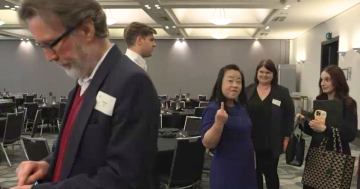Pia Lauritzen* says effective leadership isn’t about giving or taking responsibility—it’s about sharing it.
 “We want people to be accountable. They shouldn’t wait for the executive team to tell them what to do.
“We want people to be accountable. They shouldn’t wait for the executive team to tell them what to do.
“They should help each other navigate the constant change and uncertainty our company faces.”
When I hear executives say things like this, I am optimistic.
That’s exactly what global companies require: leaders who understand the need for distributed responsibility and locally anchored ownership.
It’s those qualities that bring better results and greater employee satisfaction.
But simply understanding the need for distributed responsibility is not sufficient if leaders don’t understand what it means to demonstrate responsibility themselves.
One way of demonstrating responsibility is through the process of asking and answering questions.
Many get at least one part of the process right: by responding to the questions received from their employees, leaders believe that they are showing themselves to be reliable and trustworthy.
This isn’t too far off base.
The word responsibility, after all, stems from the Latin respons, meaning respond or answer to.
Unfortunately, by not asking questions themselves, leaders prevent employees from demonstrating the same kind of reliable and trustworthy behaviour—and that makes it harder to embed the locally owned responsibility that they are looking for.
During my research into how people living in different language cultures, particularly children and teachers, use questions to distribute responsibility, I identified three basic ways that people can use questions to both demonstrate responsibility and foster it in others.
The first focuses on the questioner and her intentions in asking the question.
The second focuses on the responsibility of the recipient to provide a response to the question.
And the third, which is the most important, focuses on the co-creation of responsibility that happens when people take turns asking and answering questions.
By knowing and consciously switching between all three ways of asking questions—and particularly by focusing on the third—leaders have a better chance of creating a culture in which everyone feels responsible for the company’s success.
Most leaders, however, only concentrate on the second way.
Over the past 15 years, I have studied informal communication and behavioural patterns in large organizations, using a method that encourages people to ask each other questions.
Throughout hundreds of companies representing all kinds of industries, leaders seem to have one thing in common: they respond to more questions than they ask.
In a recent example from a large manufacturing company, one senior executive received and responded to a total of 31 questions.
He asked only nine questions himself.
This answer-driven behaviour is so consistent across companies that it suggests a universal leadership culture: leaders not only prioritize answering questions over asking them, but they also pride themselves on responding quickly and accurately—and they feel ashamed if they are too busy or otherwise unable to provide satisfactory answers to their employees and superiors.
As a member of the C-suite in another manufacturing company recently confessed to me and her leadership team: “This organizational analysis has become my guilty conscience.
I have been dreading hearing about the results, because I know I have let everyone down by not answering the many questions I received.” She never stopped to think about the questions she didn’t ask.
Her only concern was the questions she didn’t answer.
In a previous strategy+business article, I introduced the magical question triangle.
Its premise: when we ask questions, we automatically activate our ability to consider our own position, connect with each other, and commit to a shared purpose.
This three-part approach correlates with the three different ways of using questions to distribute responsibility.
- “I am responsible (for knowing the right answer)”
When leaders use questions to assume responsibility themselves, they think, talk, and behave in a way that puts them at the centre of attention (see the left side of the figure above).
The questions they ask are quiz or test questions designed to confirm that the respondents see the world in the same way the leader does—e.g., “What are the components of a good marketing campaign?”
In my observational studies of schoolchildren being taught in their respective native languages, the way questions were asked telegraphed an expectation to the children.
For example, in one setting, when the teacher asked a question all the children looked at her, not only expecting her to explain the question but also to provide the correct answer.
Leaders who primarily use questions to take responsibility themselves should not expect their employees to feel comfortable asking their own questions and sharing their unique perspectives and input.
- “You are responsible (for providing your own answer)”
When leaders use questions to impose responsibility on others, they think, talk, and behave in a way that suggests each individual needs to find their own answers and make their own decisions (see the middle of the figure above).
The questions leaders ask are coaching questions designed to make the respondent reflect and behave in accordance with what the respondent believes is right—e.g., “What can you do differently to improve collaboration with your colleagues?”
In some cultures, there is a clear preference for this kind of question.
When a Danish teacher asks a question, for example, she typically doesn’t address the whole class, but one or a few students whom she expects to take responsibility for their own learning and development.
Leaders who have a preference for this question strategy should not expect their employees to be aligned on what is important for their company or team to succeed, because everyone is focused on succeeding with their own projects and priorities.
- “We are responsible (for co-creating the best possible answer)”
When leaders use questions to reinforce shared responsibility, they think, talk, and behave as if everyone is already on the same page (see the right side of the figure above).
The questions they ask are topic-focused and designed to make everyone concentrate on the same things at the same time.
In my observational studies in the classroom, when teachers use this approach, they neither draw attention to themselves nor to selected children.
Instead, they expect everyone to pay attention and contribute to the subject—e.g., “What do we know about our value chain that can help us make the necessary improvements?”
In a research project that looked at the impact of 15,893 questions asked by employees at 32 companies, we found that the difference between using “you” and “we” when asking a question has profound impact on how the people receiving the question behave.
Questions that use “we” had a higher response rate, provoked spontaneous positive responses that were longer and more informative than the average answer, and inspired new questions and conversations.
By contrast, those that used “I” often went unanswered and didn’t lead to discussions.
This is because the choice of pronouns leaders use signals who is taking responsibility.
There is a clear distinction between “I/me” and “you,” but using “we” is more likely to help people connect with each other and commit to a shared purpose—and shared responsibility
A good way to demonstrate what responsible behaviour looks like in a constantly changing world is for leaders to practice doing the small things differently.
For example, this includes resisting the temptation to provide their own answers to all the questions they receive and instead inviting others to explore and answer some of the questions with them.
By doing this, they avoid creating a gap between themselves—“I”—and their employees—“you.”
Using “we” invites people to contribute.
Although these may seem like micro-changes in how leaders speak and act, they can make a big difference in how responsibility is perceived and practiced throughout the company.
By using “we,” leaders can show their understanding of responsibility and make room for everyone to feel an obligation to move the conversation forward.
If leaders say they want people to be accountable, it’s up to them to make sure that the conversation doesn’t end with them and the answers they do—or do not—provide.
If they want people to come up with their own solutions, leaders must put their own solutions on hold, even if it means they don’t always come across as the most knowledgeable people in the room.
And if they want their employees to help one another navigate the constant change and uncertainty the company faces, leaders must place the need for shared responsibility above the need to take sole responsibility by setting themselves up as the ultimate authority.
When I went over the organizational analysis with the executive who was fearful because she hadn’t answered all the questions she received from employees, I congratulated her.
I told her that she now had a chance to engage her employees in discussing possible answers, which would encourage a shared responsibility for solving problems.
None of us has the time and knowledge we wish we had—so we must help one another create a culture where no one is ashamed of not having all the answers.
*Pia Lauritzen is an advisor to executives and cofounder of Qvest, a technology company that developed a platform for creating responsible organizations in which people work together to reach important goals.
This article first appeared at strategy-business.com











